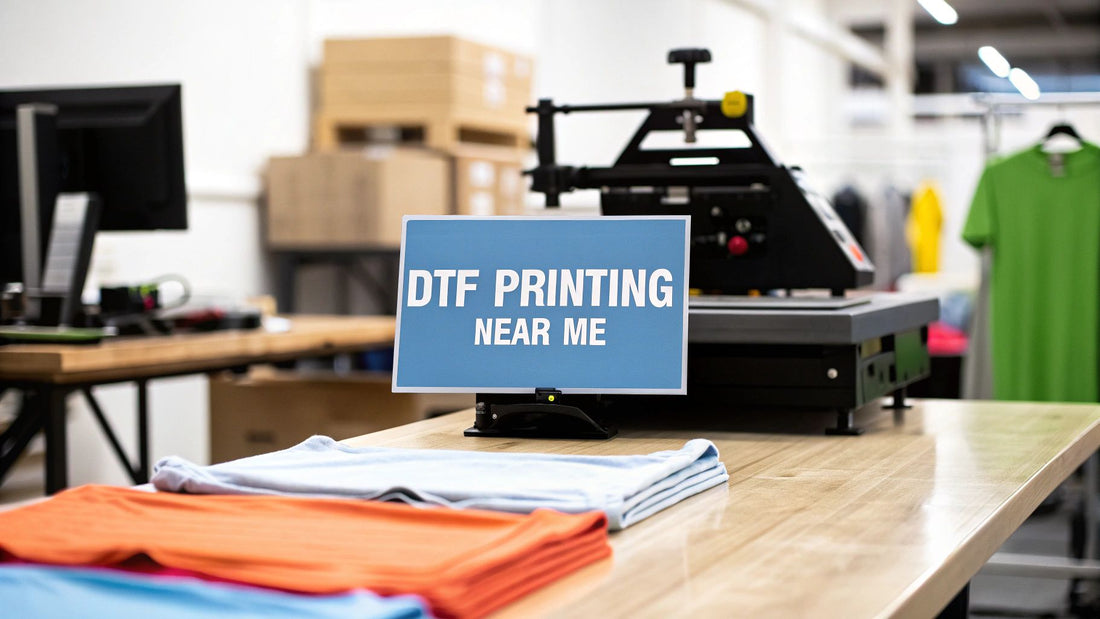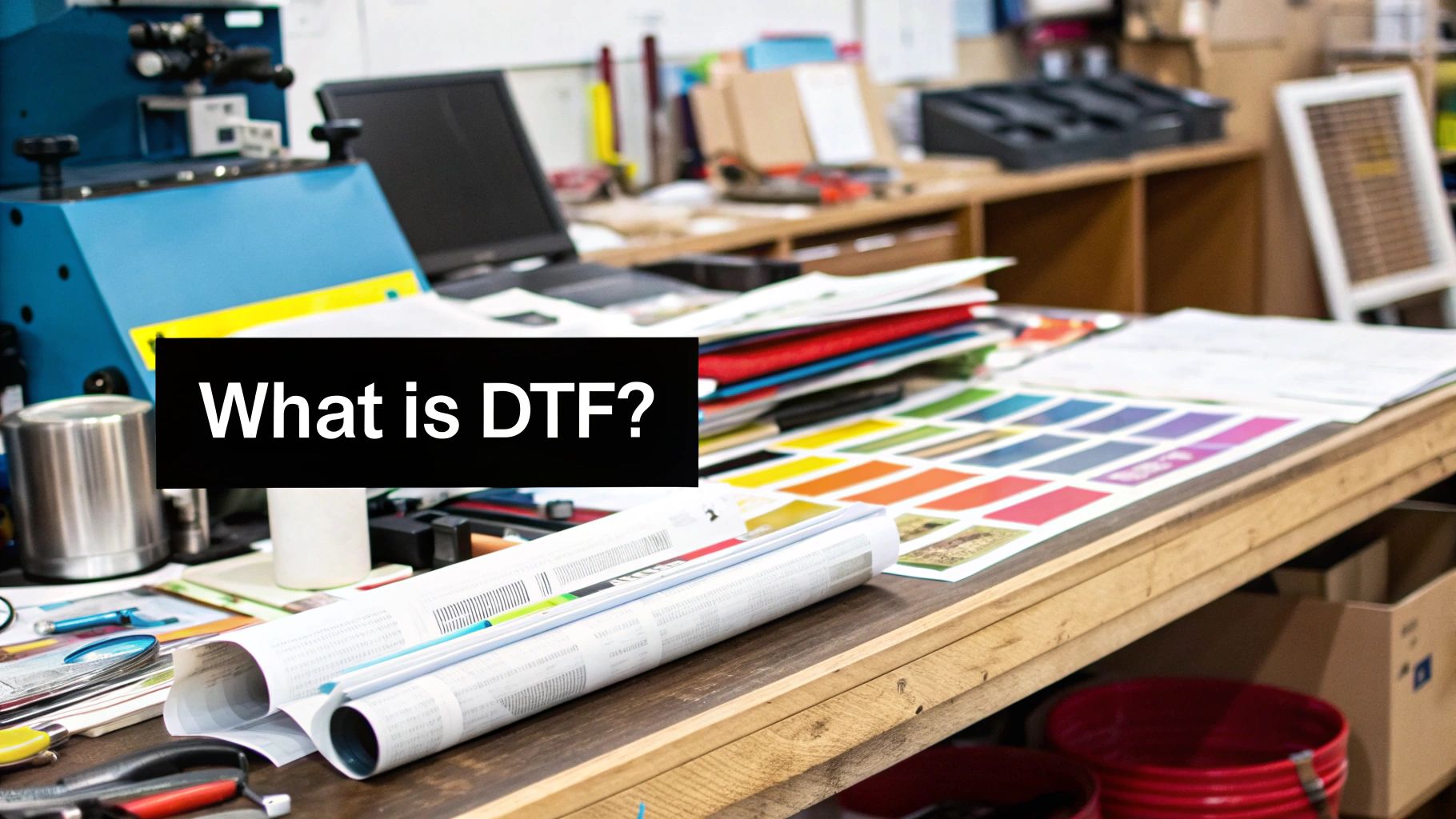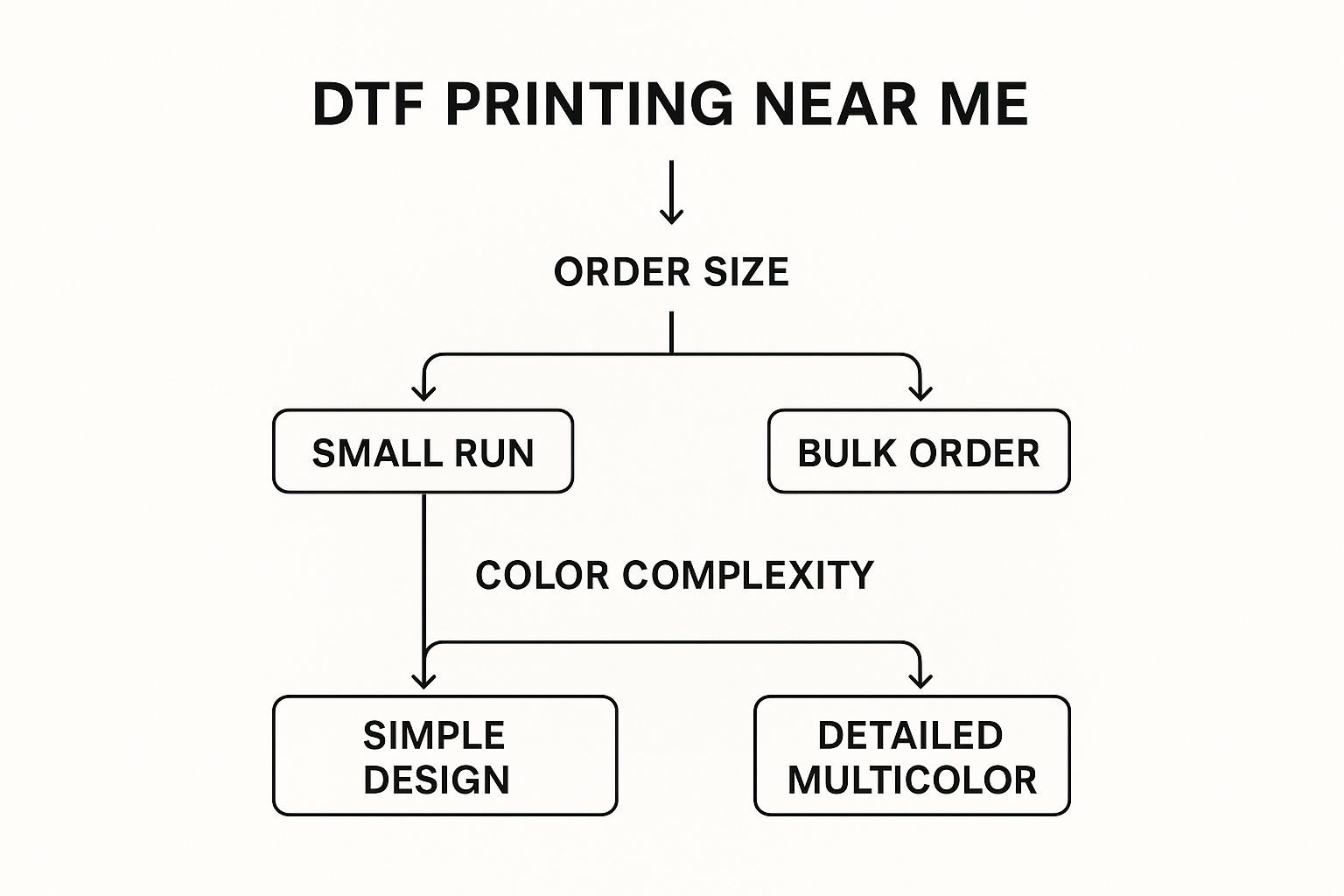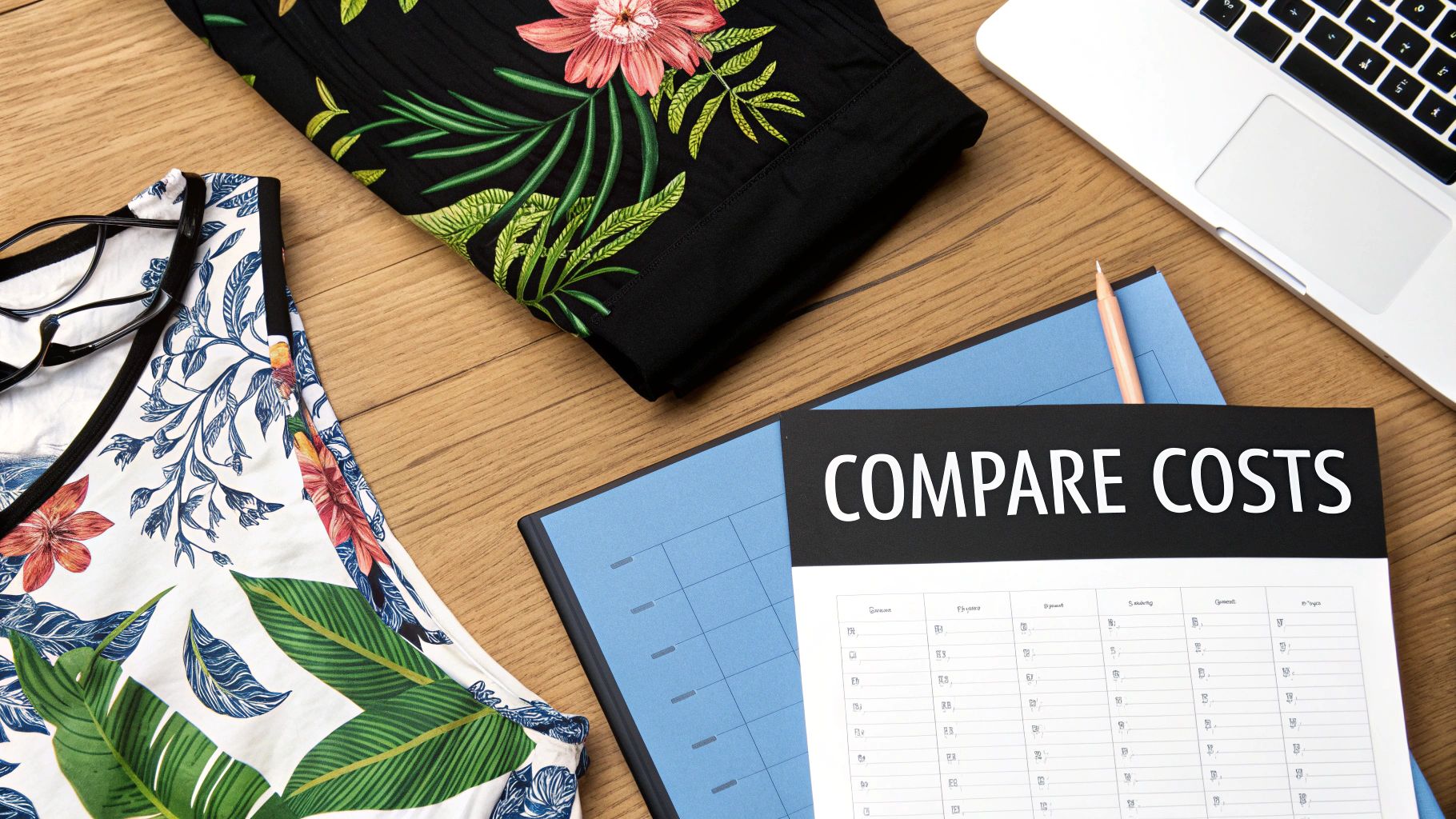
How to Find DTF Printing Near Me That Delivers Quality
Share
When you type "dtf printing near me" into a search bar, you’re doing more than just looking for a service. You’re looking for a partner—someone who can take your creative vision and make it a reality. Finding the right local printer can be a game-changer, slashing your project timeline, getting rid of shipping hassles, and giving you the peace of mind that comes with seeing a real sample before you greenlight a big order.
Why a Local DTF Printer Is Your Best Bet
The right print partner can truly make or break a project. Sure, online-only services are everywhere, but they just can't compete with the real, tangible benefits of working with a professional in your own backyard. Choosing a local DTF printer means you can shrink turnaround times from weeks down to just a few days. That’s a huge deal for time-sensitive jobs or getting new merch ready for a last-minute event.

This hands-on approach is where local printers really shine, especially for quality control. Picture this: you're launching a new t-shirt line, and getting that specific shade of blue just right is non-negotiable for your brand. With a local shop, you can actually go there, feel the fabric, and sign off on a press-check sample to make sure the colors are spot-on. This one simple step can save you from the nightmare of receiving a massive order that’s not what you wanted.
Understanding the Technology
So, what’s all the hype about? Direct-to-Film (DTF) printing is an incredibly versatile technique that delivers vibrant, durable, and highly detailed designs. Unlike older methods that only work on certain fabrics, DTF is a true all-rounder. It performs beautifully on a huge range of materials, including:
- 100% Cotton
- Polyester and Poly-blends
- Fleece and Nylon
- Even treated leather
This flexibility is why it’s become the top choice for everything from custom team jerseys to apparel with intricate branding. If you want to get into the nitty-gritty, you can learn more about what Direct-to-Film printing is and how it creates such impressive results.
The Growing Demand for Quality Printing
The buzz around DTF isn't just talk; it’s a seriously booming part of the custom apparel world. The global DTF printing market was valued at a massive USD 2.72 billion in 2024 and is expected to climb to USD 3.99 billion by 2030. This incredible growth is driven by its ability to handle on-demand customization efficiently, which cuts down on waste and fits perfectly with today’s e-commerce models.
Key Takeaway: Going with a local DTF printer isn't just about convenience. It’s a smart business move that gives you direct control over quality, faster turnarounds, and clear communication—all of which lead to a much better final product.
Smart Ways to Find the Best Local DTF Printing Services
When you type "DTF printing near me" into a search bar, you're usually met with a list of companies that are great at one thing: online advertising. But the best local print shop for your project might not be the one with the biggest marketing budget. To find the real gems, you need to dig a little deeper.
Think of it less like a simple search and more like a proper investigation. A multi-pronged approach will give you a solid list of potential partners who can truly deliver the quality and service you're after.
Start by refining your online search terms. Instead of something generic, get specific. Try phrases like "custom apparel DTF transfers in Brooklyn" or "local DTF printing for small businesses in the Mission District." This simple tweak helps push past the big national players and surface the smaller, more specialized shops in your actual community.
Go Beyond Search Results with Google Maps
Google Maps is one of your best friends in this process. It’s not just for getting directions; it's a goldmine of real-world feedback. A quick search on Maps gives you an instant visual layout of printers in your area, complete with star ratings, customer photos of actual finished products, and detailed reviews.
For example, searching "custom t-shirt printing" in your city shows you exactly what I mean. You can immediately spot the businesses people are raving about.
This visual overview lets you quickly create a shortlist. You can see at a glance who is consistently earning five-star reviews and who you might want to steer clear of, all based on genuine customer experiences.
Discover Hidden Talent on Social Media
You'd be surprised how many incredible printers fly completely under the Google radar, building their entire reputation on social media. Platforms like Instagram and Facebook are essentially live portfolios, and they're fantastic for finding local talent.
Here are a few tricks I've used that work like a charm:
- Go Hashtag Hunting: Get creative with local hashtags. Search for things like #PhillyTees, #ATLCustomApparel, or #DenverPrinters. This often leads you directly to a printer's feed, where their work does all the talking.
- Tap into Local Communities: Jump into Facebook groups for local small businesses, artists, or fashion entrepreneurs. A simple post asking, "Who do you all recommend for high-quality DTF printing locally?" can generate a flood of honest, vetted recommendations.
I once found an amazing local printer by searching #ChicagoMakers on Instagram. Their feed was packed with vibrant, high-quality work, but they were nowhere to be found on the first page of Google search results.
By combining smarter web searches with the social proof from Google Maps and the visual deep-dive of social media, you build a much more reliable list. You’re no longer just picking the top search result; you're finding a true partner who has the skills and reputation to bring your project to life.
How to Properly Vet a Local DTF Printer
Okay, so you've searched "DTF printing near me" and have a shortlist of local shops. Now for the important part: figuring out who’s a seasoned pro and who just bought a machine last week. It’s all about digging deeper than a pretty website and asking the right questions.
Start by really scrutinizing their online portfolio. Don't just scroll through; look for consistency. Are the colors popping on both black hoodies and white tees? Is the line work on intricate designs clean and sharp? A truly experienced printer will have a gallery showcasing a wide variety of projects on different fabrics, which proves they know how to handle more than just the easy stuff.
Examine Their Digital Footprint
A curated portfolio is one thing, but what are actual customers saying? This is where you put on your detective hat and check out reviews on Google, Yelp, and their social media channels. Don’t just look at the star rating—read the comments.
Look for patterns. Are people constantly raving about great communication and fast turnarounds? That’s a great sign. On the other hand, if you see multiple complaints about missed deadlines or prints that peeled after one wash, that’s a major red flag. One bad review might be a fluke, but a trend is a warning.
This decision tree helps visualize how your specific project needs can steer you toward the right type of printer.

As you can see, the ideal shop for a huge batch of simple, one-color logos is probably not the same one you'd choose for a small run of complex, full-color art pieces.
Inquire About Their Process and Materials
Once you've done your online recon, it's time to make contact. A professional printer won't be shy about their process or the gear they use. These details directly impact how your final product will look, feel, and hold up over time.
Don't hesitate to ask some pointed questions:
- What DTF printer and curing equipment are you running? Pro-level machinery usually means more reliable, higher-quality output.
- What brands of ink and adhesive powder do you use? Quality consumables are everything. Cheap stuff leads to cracking, peeling, and fading.
- Can I get a sample? This is the ultimate test. There’s no substitute for getting a physical print in your hands to check the feel, stretch, and overall quality before you place a big order.
A printer who gets cagey about their materials or won’t provide a sample is likely cutting corners somewhere. True pros are proud of their work and are more than happy to talk shop about why they use certain films or inks to get a premium result.
To help you stay organized, use a simple checklist to compare the shops on your list.
Local DTF Printer Evaluation Checklist
Here’s a quick reference table to help you compare your top contenders side-by-side. Just jot down your notes as you research each one.
| Evaluation Criteria | Printer A Notes | Printer B Notes | Printer C Notes |
|---|---|---|---|
| Portfolio Quality (Vibrancy/Detail) | |||
| Online Review Patterns (Positive/Negative) | |||
| Responsiveness to Inquiry | |||
| Transparency on Equipment/Materials | |||
| Sample Availability & Quality | |||
| Pricing/Turnaround Time | |||
| Overall Gut Feeling |
This simple exercise can make your final decision much clearer by laying out all the facts in one place.
The source of their supplies matters, too. For example, printers who use high-quality, domestically sourced consumables often produce a far more consistent and durable transfer. Digging into the benefits of using made in USA DTF suppliers can give you a better idea of why this is such an important quality signal.
By combining a thorough portfolio review, some online sleuthing, and direct questions, you’ll have everything you need to pick a local partner who can deliver fantastic results every time.
Understanding DTF Pricing and How Quickly You'll Get Your Order

When you start searching for "DTF printing near me," two questions probably jump to the front of your mind: "How much is this going to cost?" and "How fast can I get it?" Getting a handle on how local shops calculate their prices and estimate turnaround times is crucial. It’s the key to budgeting properly and making sure there are no nasty surprises waiting for you.
A printer's quote isn't just a number they pull out of thin air. The final price is almost always a mix of a few key things: the size of your order, how complex your artwork is, and how many different spots on the garment you want printed. A simple logo on the chest is naturally going to be cheaper than a shirt with full-color designs on the front, back, and both sleeves.
How Most Shops Structure Their Prices
You’ll find that most local printers work with a tiered pricing model. If you just need one or two items for a personal project or a sample, you’ll likely pay a standard per-piece rate. Simple and straightforward.
But the real savings kick in with larger orders. The price per item starts to drop once you hit certain quantity breaks—maybe at 12, 24, or 50 pieces. This is what makes DTF so great for growing brands; the more you order, the better your price gets.
My Advice: Always ask for quotes at a few different quantities. You might be surprised to find that ordering just five more shirts (say, 25 instead of 20) bumps you into a better price tier, making each shirt significantly cheaper.
The good news for all of us is that the DTF printer market is booming. Technology is getting better and faster, which helps bring costs down for everyone. In fact, the market was valued at USD 667 million in 2025 and is only expected to grow. For more details on this trend, check out the DTF printer market growth analysis on MarketReportAnalytics.com.
Why Local Shops Win on Turnaround Times
This is where finding a good local printer really pays off. Big online-only companies might quote you a week or more just for the printing part, not even including shipping. A local shop, on the other hand, can often get an order done in just a few business days. Some even offer same-day or 24-hour rush services if you're in a real pinch.
To get a quote quickly and accurately, make sure you have your details ready to go before you even call or email them.
- Your Artwork: Have your final design ready. The best format is a vector file (like an AI or EPS), but a high-resolution PNG (at least 300 DPI) with a transparent background also works perfectly.
- Your Quantity: Know the exact number of items you need.
- Garment Info: Be specific about what you’re printing on—t-shirts, hoodies, totes, etc.—and include the material and color.
- Print Specs: Know the dimensions of your print and exactly where you want it placed on the garment.
Keep an Eye Out for Hidden Fees
A good, trustworthy printer will be upfront about all their costs, but it never hurts to ask directly. Before you give the final go-ahead, just confirm if there are any other charges to be aware of.
Some common ones to look for include:
- Setup Fees: A one-time charge for getting your digital file prepped for their machines.
- Rush Charges: Need it yesterday? Expect to pay a premium for jumping the queue.
- Color Matching: If you need a very specific Pantone color, they might charge a little extra to get it just right.
Going in with this knowledge means you can talk to any DTF printer with confidence. You'll know what to ask, how to provide your information, and what their quote actually means for your budget and timeline.
Getting Your Artwork Print-Ready
Here’s a hard truth: the final print will only ever be as good as the file you send. Even the most advanced DTF printer can't magically fix a blurry, low-resolution design.
But the good news? You don't need to be a graphic design wizard to get this right. Just a few key pointers will ensure what you see on your screen is exactly what you get on your shirt, saving you from the classic pitfalls that lead to delays and disappointment.
The Vector vs. Raster Showdown
In a perfect world, your printer would get a vector file every single time. We're talking about formats like AI (Adobe Illustrator), EPS, or SVG. These files are built with math, not pixels, meaning you can scale a design from a tiny pocket logo to a giant back print without losing a shred of quality. It stays perfectly crisp.
More often than not, though, you’ll probably be working with a raster file. These are your everyday pixel-based images, like a PNG or JPEG. If you zoom in far enough, you can literally see the little squares of color. This is why trying to blow up a small raster file results in a blurry, pixelated mess—a printer's nightmare.
Don't panic if a PNG is all you have! A high-quality raster file works beautifully for DTF printing, provided it meets a couple of critical requirements.
Pro Tip: Vector is king for flexibility, but a top-notch raster file is more than capable for DTF. The real deal-breakers are resolution and background transparency. Let's dig into those.
Your Final Artwork Checklist
Before you hit 'send' on that email to your chosen printer, run through this quick pre-flight check. Nailing these things upfront will save you a ton of back-and-forth and make the whole process smoother.
-
Resolution is Non-Negotiable: 300 DPI. This is the magic number. DPI stands for "dots per inch," and it’s the standard for high-quality printing. A 300 DPI file ensures every line is sharp and every detail is clear. Web images are typically 72 DPI, and if you try to print one of those, it will look fuzzy and unprofessional.
-
Kill the Background. Unless you want a solid box printed behind your design, the background must be transparent. This is crucial. Always save your final file as a PNG, as it’s one of the few formats that preserves transparency. If you send a JPEG with a white background, guess what? The printer will print a big white box on your shirt.
-
Size It Right. Make sure your artwork is saved at the exact physical dimensions you want it printed. If the design needs to be 10 inches wide on the final t-shirt, your digital file should be saved at 10 inches wide (at 300 DPI, of course).
Getting your artwork dialed in is the most important hand-off in the printing process. For a deeper dive into this, check out our complete guide on how to prep your art for a perfect DTF printing shirt. A clean file means a happy printer and a final product you'll absolutely love.
Getting Your Order Just Right
You've put in the work, sifted through your options, and finally pinpointed the best local DTF printer for your project. Now comes the moment of truth: placing the order. This is where clear communication and attention to detail make all the difference, ensuring the final product looks exactly like you imagined.

Before you go all-in on a big run, always ask for a single sample print. For any significant order, this is non-negotiable. Holding a physical sample is the only way to truly feel the texture, see the color accuracy in person, and test the transfer's stretch and durability. It’s the ultimate quality check that a digital proof on a screen can never match.
Nail Down the Specifics
Once the sample gets your stamp of approval, it's time to provide crystal-clear instructions for the full job. Don't leave anything up to interpretation. I find it's best to send a simple, organized list that covers:
- Final Quantities: The exact number of transfers you need. No more, no less.
- Garment Details: If they are pressing for you, list every size and color for each garment.
- Print Placement: Confirm the precise location and dimensions for the print on the garment.
The demand for custom apparel is pushing printing technology forward at an incredible pace. Printers are investing in machines that are not only faster but also produce higher-quality results. Some of the newer equipment can produce transfers up to four times faster than older models, which also helps keep costs down for everyone. It's a huge win for the industry. You can dig deeper into how technology is shaping the DTF printing market on GlobeNewswire.
Pro-Tip: Scrutinize the Final Proof
Before a single drop of ink is used, your printer will send over a final digital proof or mock-up. Go over this thing with a fine-tooth comb. Double-check every word, color, placement, and measurement. This is your last chance to catch an error before it's too late.
Once you give the green light, your order heads to production. Make sure you're also clear on the payment terms and the timeline for pickup or delivery. This final bit of communication ensures a smooth handoff, helps you build a great relationship with your new local partner, and sets you up for a fantastic finished product.
Still Have a Few Questions?
Even after you've scouted out a few potential "DTF printing near me" options, you probably have some lingering questions. That's totally normal. Getting these last few details ironed out is the key to making sure your project goes smoothly, without any last-minute hitches.
So, How Many Do I Have to Order?
This is where DTF printing really shines. For the most part, local shops have no minimum order quantity (MOQ). It’s a game-changer if you just need a single prototype, a few shirts for a bachelor party, or a small test run for your brand.
That said, always double-check. A shop might be happy to print just one for you, but you'll almost always see the per-item price drop once you hit a certain number, maybe around 12 or 24 pieces. It's all about those price breaks.
Can I Bring My Own T-Shirts?
Usually, the answer is yes, but you absolutely have to ask first. Some printers are totally cool with you bringing in your own garments. Others, however, prefer to stick with their own tried-and-true inventory. This isn't them being difficult—it's about quality control. They know how their ink and transfers react with their specific shirts, which helps guarantee a great result every time.
A Word of Advice: If a printer does let you supply your own apparel, they'll likely have rules about what fabrics they can work with. And, fair warning, they probably won't replace your shirt if a misprint happens. This is one of those times where a quick, clear conversation upfront saves everyone a headache later.
This kind of flexibility is exactly why finding a good local DTF partner is such a fantastic option for creators and businesses of all sizes.
Ready to skip the search and get vibrant, American-made DTF transfers delivered right to your door? Cobra DTF offers premium quality with fast, reliable shipping. Order your custom DTF transfers today!
